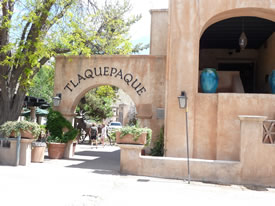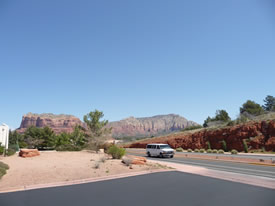Travel Tales
Arizona:
Spectacular Sedona
The Mystery of the Red Rocks.
Travel Tale No. 3 - Vol. 5

Sedona was named after the industrious wife of the first postmaster of that area: Sedona Arabelle Miller Schnebly. (1877-1950) The red rock color found in Sedona is due to most of the layers of hematite, or iron oxide, and about 80 million years of sediment deposits. Each layer was deposited in its own geologic era. Some layers were deposited in shallow seas, river deltas and flood plains; and some are hardened sand dunes. All of these strata, except the basalt, were laid down one atop another during the Paleozoic era. During this era, fishes dominated the oceans and plants and amphibians were just starting to live on land. These rocks have not eroded even though wind and water have assaulted them for 275 million years.
Ad Magorem Dei Gloria
 Sedona is also believed to be a vortex site with places of power in the red rocks that enhance prayer and meditation for people of all faiths. Another area of reflection, is the Chapel of the Holy Cross, designed by sculptor Marguerite Brunswig Staude, who owned a ranch in the Oak Creek Canyon. Architect, Frank Lloyd Wright, built the first architectural model with the articulated cross, and the architects Anshen & Allen, decided to build the church 250 feet high in the rock, solid as the “rock of Peter.” William Simpson Construction Company broke ground in 1955. Although Roman Catholic in faith, the art of the chapel dedicated to the memory of Mrs. Staude’s parents, Lucien and Marguerite Brunswig, has universal appeal to people of all faiths, and its doors are open to all, as evidenced by the thousands of signatures, including mine, in the Guest Registration Book. There is a tiny gift shop below this lovely unusual chapel.
Sedona is also believed to be a vortex site with places of power in the red rocks that enhance prayer and meditation for people of all faiths. Another area of reflection, is the Chapel of the Holy Cross, designed by sculptor Marguerite Brunswig Staude, who owned a ranch in the Oak Creek Canyon. Architect, Frank Lloyd Wright, built the first architectural model with the articulated cross, and the architects Anshen & Allen, decided to build the church 250 feet high in the rock, solid as the “rock of Peter.” William Simpson Construction Company broke ground in 1955. Although Roman Catholic in faith, the art of the chapel dedicated to the memory of Mrs. Staude’s parents, Lucien and Marguerite Brunswig, has universal appeal to people of all faiths, and its doors are open to all, as evidenced by the thousands of signatures, including mine, in the Guest Registration Book. There is a tiny gift shop below this lovely unusual chapel.
Adventure Seekers
The first settlers were ranchers and farmers who planted peach and apple trees. For the adventure seekers with cameras there are balloon flights with panoramic views, air tours to the North and South Rim Grand Canyon. There is a cliff Castle Casino and Hotel for gambling; golf and tennis at several resorts. For the kids, there are hiking and mule trails, horse-back riding, biking, swimming, and information about the Navajo, Havasupai, Zuni, Apache and other Native American tribes. There are many information centers around this town of 11,000 people that will gladly provide you with free maps and drinking water, and data about all the myriad of activities to do in this beautiful area. But one word of caution, free parking is limited and expect to encounter hundreds of tourists shopping and visiting the psychic shops as four million people visit Red Rock Country annually, and it can get very crowded and hot.
Coconino National Forest
 The sad part about the natural beauty of Sedona is that it has become overly-commercialized. Although the 160,000-acre Coconino National Forest District Ranger is trying to alert the public to the sensitivity of the delicate ecosystem, a system which needs 44,000 hours of volunteer service in place to offset the inadequate federal funding, a campaign is in force to educate the public and ask visitors to remove their trash and pack it back out with them. Rvs, trailers and buses are not recommended, as the human impact on a delicate living system is quickly destroying the sensitive ecosystem of the area.
The sad part about the natural beauty of Sedona is that it has become overly-commercialized. Although the 160,000-acre Coconino National Forest District Ranger is trying to alert the public to the sensitivity of the delicate ecosystem, a system which needs 44,000 hours of volunteer service in place to offset the inadequate federal funding, a campaign is in force to educate the public and ask visitors to remove their trash and pack it back out with them. Rvs, trailers and buses are not recommended, as the human impact on a delicate living system is quickly destroying the sensitive ecosystem of the area.
America the Beautiful
 The Red Rock Pass Program was authorized by Congress as a Federal Lands Recreation Act (REA) in 2004, as a means of conserving, protecting and restoring the natural and cultural resources. 30% of its budget goes to “trash pickup.” Arizona state park passes can be purchased for $6.00 - $125.00. For information: www.azstateparks.com, or 602-542-4174. A Federal Interagency Senior Pass, may be purchased by any U. S. citizen, or permanent resident of the USA, who is at least 62 years old for $10.00. Public lands are one of America’s great treasures. Nearly one third of the country belongs to its citizens. Please keep America pristine to celebrate its recreation and spiritual value and playground for all to enjoy. Pack it back out!
The Red Rock Pass Program was authorized by Congress as a Federal Lands Recreation Act (REA) in 2004, as a means of conserving, protecting and restoring the natural and cultural resources. 30% of its budget goes to “trash pickup.” Arizona state park passes can be purchased for $6.00 - $125.00. For information: www.azstateparks.com, or 602-542-4174. A Federal Interagency Senior Pass, may be purchased by any U. S. citizen, or permanent resident of the USA, who is at least 62 years old for $10.00. Public lands are one of America’s great treasures. Nearly one third of the country belongs to its citizens. Please keep America pristine to celebrate its recreation and spiritual value and playground for all to enjoy. Pack it back out!
Camping and Hiking
 Because of intense use of Red Rock Country, the area around Sedona is closed to camping. Backpacking is permitted in some wilderness areas. Camping is allowed along Schnebly Hill Road east of Schnebly Hill Vista, 6 miles from Sedona. For hiking wear a hat and sunscreen and hiking boots. Also carry one gallon of water per person, per day, no matter what time of year. Keep dogs on a leash because you might encounter a herd of javelina (wild pigs), while not aggressive, they do have sharp canine teeth that can inflict a nasty bite. They usually feed at night during the summer months but do not see well so depend on their great sense of smell. If you are lucky, you might see a coyote (canis latrans) a very adaptable dog, sometimes called a “songdog” because of its barks, howls and yips.
Because of intense use of Red Rock Country, the area around Sedona is closed to camping. Backpacking is permitted in some wilderness areas. Camping is allowed along Schnebly Hill Road east of Schnebly Hill Vista, 6 miles from Sedona. For hiking wear a hat and sunscreen and hiking boots. Also carry one gallon of water per person, per day, no matter what time of year. Keep dogs on a leash because you might encounter a herd of javelina (wild pigs), while not aggressive, they do have sharp canine teeth that can inflict a nasty bite. They usually feed at night during the summer months but do not see well so depend on their great sense of smell. If you are lucky, you might see a coyote (canis latrans) a very adaptable dog, sometimes called a “songdog” because of its barks, howls and yips.
 More than likely, you will see a turkey vulture, a large black soaring scavenger with white under wings, or a red tail hawk with a distinctive call: “keeeer!” Also many quail abound with their chicks numbering in the dozen. They are recognizable by the prominent tear-drop shaped feather on top of their heads. However, observe the animals from a distance for your own safety. Scorpions, although seldom seen, are found under rocks and in shady places. Snakes also look for shade under rocks, so don’t put your hands where you can’t see wildlife. Keep dogs on leashes at all times as cases of rabies have been recently reported. There are also many skunks, rabbits and tarantulas (large hairy spiders) around.
More than likely, you will see a turkey vulture, a large black soaring scavenger with white under wings, or a red tail hawk with a distinctive call: “keeeer!” Also many quail abound with their chicks numbering in the dozen. They are recognizable by the prominent tear-drop shaped feather on top of their heads. However, observe the animals from a distance for your own safety. Scorpions, although seldom seen, are found under rocks and in shady places. Snakes also look for shade under rocks, so don’t put your hands where you can’t see wildlife. Keep dogs on leashes at all times as cases of rabies have been recently reported. There are also many skunks, rabbits and tarantulas (large hairy spiders) around.
Common Plants
 In the desert, you can always tell where there is water by the cottonwood trees (populous fremontii) since they like to keep their roots wet. The prickly pear cactus is gorgeous in the spring with its bright yellow blossoms that turn to bright red fruit in late summer. The juniper tree is also very pretty with its scales and highly aromatic blue berries. You can find the Arizona cypress tree in dry washes with its curly, paper-like bark and blue color of the scales and round cone. The ocotillo displays its orange flame-like flowers with the passion of a peacock, only rivaled by the intense show-off yellow flowers of the palo verde tree. Beautiful to look at but hard on your allergies. The banana yucca is a resplendent member of the agave family with creamy white, waxy flowers that become the “banana” fruit. The datura meteloides, are large fragrant, white, trumpet-shaped flowers which open in the evening and close during the heat of the day. This plant also called the “moonflower” is poisonous.
In the desert, you can always tell where there is water by the cottonwood trees (populous fremontii) since they like to keep their roots wet. The prickly pear cactus is gorgeous in the spring with its bright yellow blossoms that turn to bright red fruit in late summer. The juniper tree is also very pretty with its scales and highly aromatic blue berries. You can find the Arizona cypress tree in dry washes with its curly, paper-like bark and blue color of the scales and round cone. The ocotillo displays its orange flame-like flowers with the passion of a peacock, only rivaled by the intense show-off yellow flowers of the palo verde tree. Beautiful to look at but hard on your allergies. The banana yucca is a resplendent member of the agave family with creamy white, waxy flowers that become the “banana” fruit. The datura meteloides, are large fragrant, white, trumpet-shaped flowers which open in the evening and close during the heat of the day. This plant also called the “moonflower” is poisonous.
There is so much to see and do in the Coconino National Forest, Red Rock Country, and in the spectacular views of Sedona, that this is a vacation place for the entire family with things to do to suit every taste. Some notable events hosted annually in Sedona are: the Sedona International Film Festival, Sedona Jazz on the Rocks Festival and Sedona Marathon. Hollywood has also used the area in and around Sedona to film classic movies such as: Broken Arrow, Midnight Run, Stay Away, etc.
 Tlaquepaque Shopping Center
Tlaquepaque Shopping Center
Tlaquepaque with its art work, fountains, and flowers in terra cotta pots is a must see with its native Indian sculptures, charming shops and tiny chapel.


Senator John McCain and Alinka, Fountain Hills, Arizona
Alinka
Read Travel Tales in the Archives.
